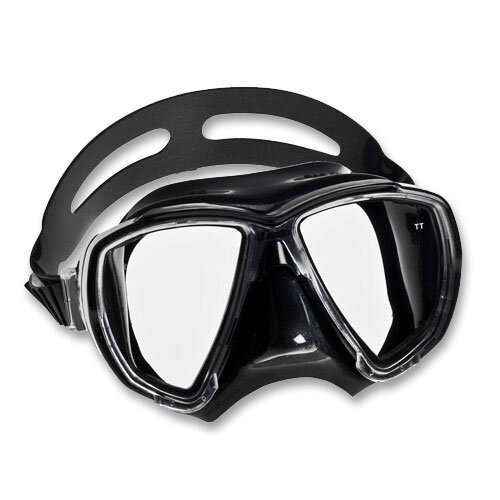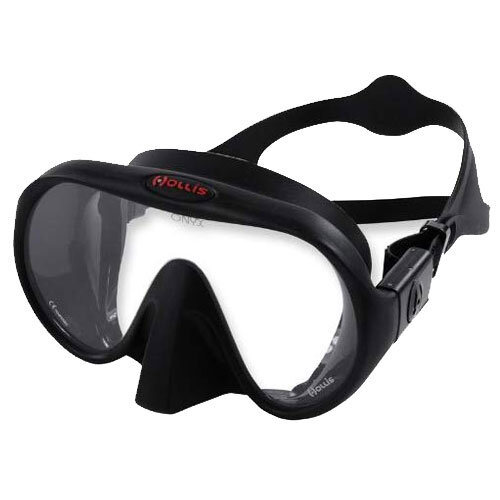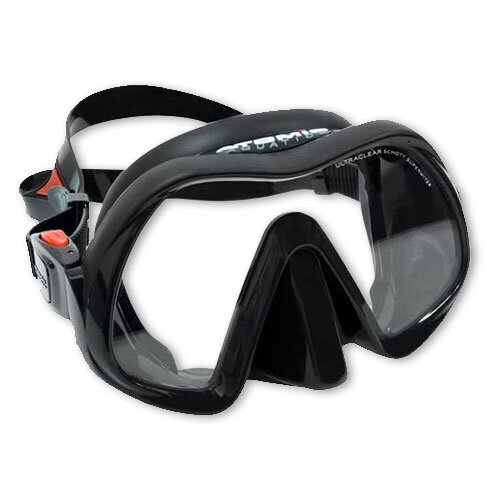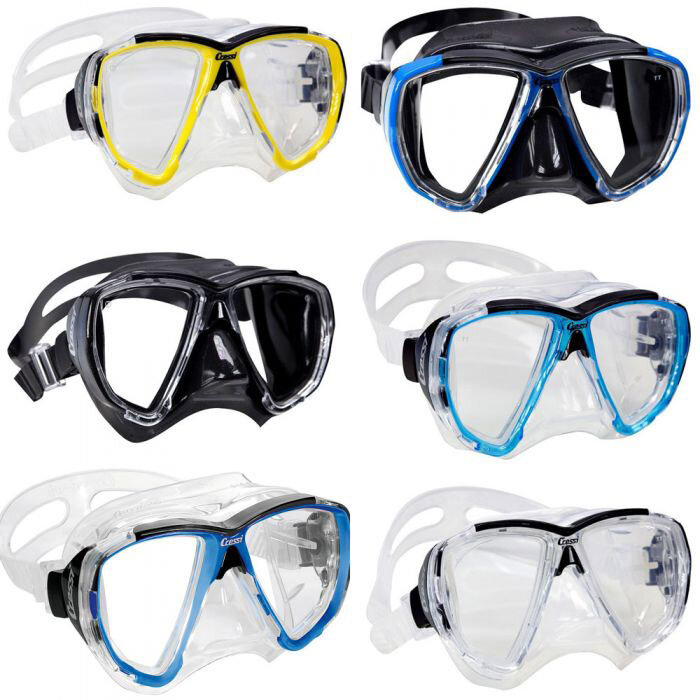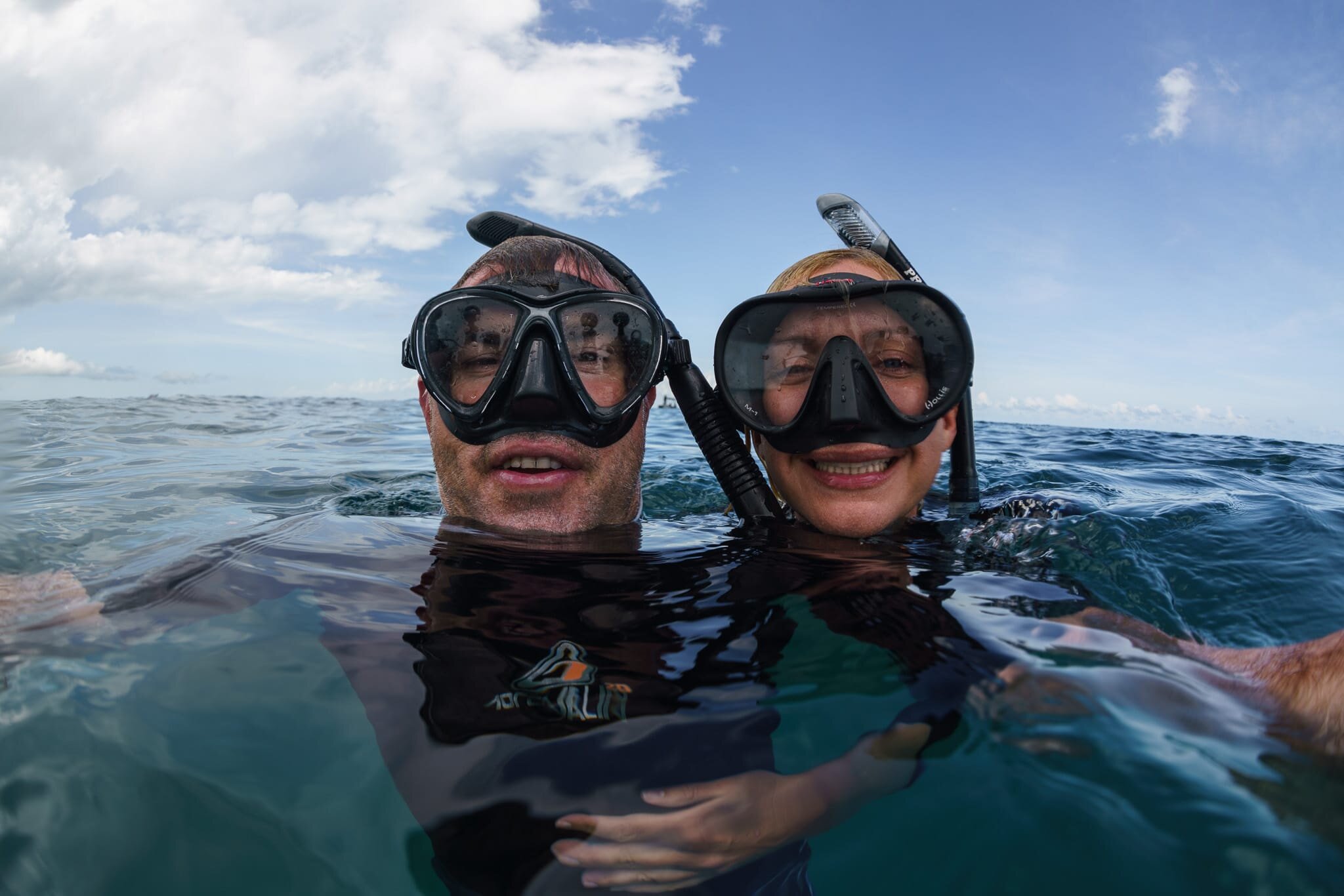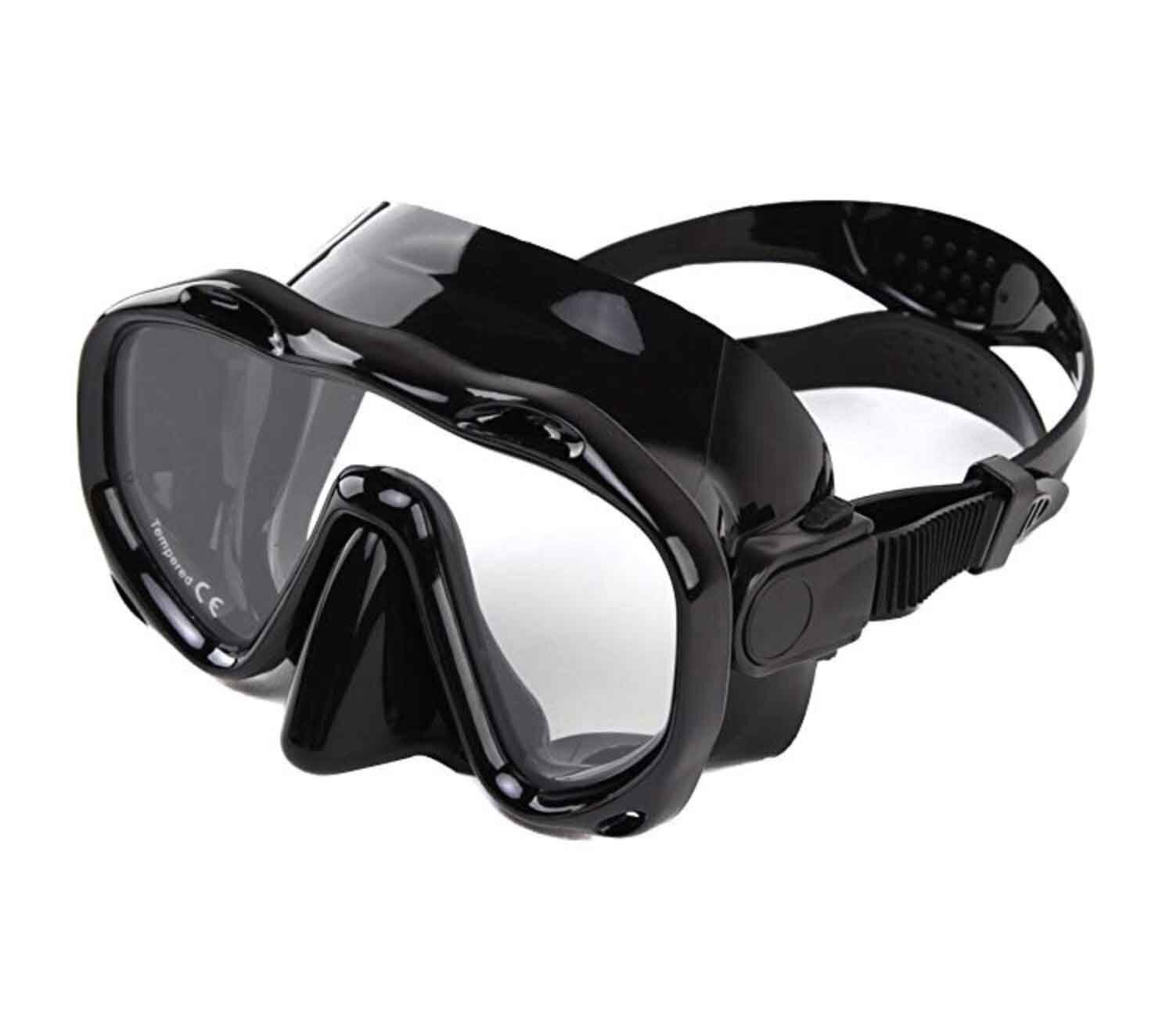The Best Mask for Diving in 2025 [UPDATED]
We are reader supported and earn affiliate commissions when you buy through us.
This guide to the best dive mask is by expert marine biologist, Dr Clare Prebble, Senior Scientist at the Marine Megafauna Foundation. Clare is also a divemaster and an underwater photographer. She’s done thousands of dives across the world.
As a marine biologist and professional diver, a good dive mask that doesn’t leak or fog is absolutely essential to my work. It’s one of the most important pieces of kit while diving (well, apart from air!). A bad mask will annoy you the whole time; a good mask fits comfortably and offers a great view so you can enjoy the dive. I’ve worked through all the options, and the best mask for diving in 2025 is the Cressi Big Eyes Evolution.
The Big Eyes Evolution is a top-end choice at a mid-range price, and we’ve tested it extensively across the world. The Cressi fits the majority of face shapes well, it’s comfortable, and has a great field of vision.
A leaky, foggy, or uncomfortable mask is the quickest way to ruin a dive. To avoid that, I’ve also uncovered other great options for masks with underwater color correction, dive masks for people with beards, big noses, small faces, wide faces, or combinations of the above.
You can click on the dive mask name below to read more customer reviews – and to check the current price – or keep scrolling to read my full Buyer’s Guide to the Best Masks for Diving.
+ Contents
QUICK COMPARISON: The Best Masks for Diving in 2023
OUR REVIEWS: The Best Masks for Diving in 2023
-
Best Color Correcting Dive Mask
ScubaPro Spectra Dive Mask -
Best Scuba Diving Mask for Big Noses
Hollis M1 Frameless Dive Mask -
Best Dive Mask for Beards
Atomic Aquatics Venom Dive Mask -
Best Diving Mask for Small Faces
Oceanic Shadow Dive Mask -
Best Scuba Dive Mask with GoPro Mount
Octomask GoPro Dive Mask -
Best Anti-Fog Dive Mask
Cressi Calibro Dive Mask -
Best Dive Mask for People with Ear Issues
IST Pro Ear Diving Mask
THE RESEARCH: Buyer's Guide the Best Masks for Diving in 2022
-
Why you can trust this guide – who am I?
-
How I identified the best scuba diving masks
-
Things to consider when choosing a dive mask
-
How do I choose the right-sized dive mask?
-
Dive mask lens coatings
-
Frame or frameless dive masks?
-
To slap strap or not to slap strap?
-
Look for ‘low profile’ dive masks
-
Dive mask windows – single, multi, or double lens?
-
Diving vs snorkeling masks
-
How to: Stop your dive mask from fogging up.
The Best Masks for Diving in 2025 are:
Cressi Big Eyes Evolution Dive Mask – OVERALL WINNER
ScubaPro Spectra Dive Mask – Underwater Color Correction
Hollis M1 Frameless Dive Mask – Big Noses
Atomic Aquatics Venom Dive Mask – Beards
Oceanic Shadow Dive Mask – Small Faces
Octomask GoPro Dive Mask – GoPro Mount
Cressi Calibro Dive Mask – Anti-Fogging
IST Pro Ear Diving Mask – Advanced Ear Protection
BTW, I’ve listed all our winners for best dive gear here that includes my best Dive computers, Dive Masks, Dive Fins, BCDs, Regulators, and Full-Face Dive Masks in 2025.
Quick Comparison of the Best Masks for Diving in 2025:
Click through to see color options, price, and read user reviews, or keep scrolling for my full reviews.
Cressi Big Eyes Evolution Dive Mask
OVERALL WINNER
ScubaPro Spectra Dive Mask
Best Dive Mask for Color Correction
Hollis M1 Frameless Dive Mask
Best Scuba Diving Mask for Big Noses
Atomic Aquatics Venom Dive Mask
Best Dive Mask for Beards
Oceanic Shadow Dive Mask
Best Diving Mask for Small Faces
Octomask GoPro Dive Mask
Best Scuba Dive Mask with GoPro Mount
Cressi Calibro Dive Mask
Best Anti-Fog Dive Mask
IST Pro Ear Diving Mask
Best Dive Mask for People with Ear Issues
Our Reviews.
The Best Masks for Diving in 2025
1. Best Dive Mask Overall
Cressi Big Eyes Evolution Dive Mask
The Cressi Big Eyes Evolution mask is comfortable during long dives, it doesn’t leak, it’s affordable, and the large double-lens glass design maximizes peripheral vision.
or, check the latest price here
Yes, I do realize this is the same as Simon’s top pick for a snorkel mask, it’s just a really great dive mask.
What I love about this scuba diving mask: The Cressi Big Eyes is a low-profile twin-lens mask with a rigid frame. The ‘Evo’ part is a reinforced silicone skirt design that makes it adaptable and comfortable to most face shapes. The thin inner seal around the nose pocket also seals pretty well against stubble apparently, should you be on holiday and enjoying your 5 o’clock shadow. The reinforced part of the seal stops the mask from compressing underwater as you descend, so you can avoid looking like a raccoon upon surfacing. The classic Cressi teardrop lens design gives a great field of vision. This is one of the best-selling masks for Cressi, and it’s favored by many scuba diving professionals.
Madeleine testing out the Cressi Big Eyes Evolution mask in Bali
The Cressi Big Eyes come in six color combinations. These masks are also available with HD mirrored lenses with several different optical corrections from -1 to -6. as well as offering comprehensive sizing options. This mask is good for snorkeling and freediving as well as diving (indeed, it’s so good that it’s our top pick for snorkelers too). It comes with its own storage box for travel as well.
Opinion: Dive professionals (in this case my husband, who has a ‘regal’ nose) note that “the high bridge and nose pocket design means it’s great for those with generous face topography”. Simon uses his Big Eyes Evolution mask for both diving and snorkeling, and loves it.
Cons: Nothing really. It has a long name I suppose? I’m stretching here. They’re great masks
2. Best Dive Mask with Color Correction
ScubaPro Spectra Dive Mask
A classic mask that looks great, is very comfortable if you’ve got a small or narrow face, helps to neutralize blue tones underwater while and its UV filters protect your eyes at the surface.
or, check the latest price here
What I love about this dive mask: The Spectra has been around for a while (like, a decade), and it’s still super popular. Recently, Scubapro has upgraded this classic mask with mirrored lenses. It’s made an excellent mask even better. The Spectra is made from tempered glass for durability, with the newer mirrored lenses offering glare-free and more true-to-life color underwater. The finish also protects your eyes at the surface (like sunglasses). Added bonus - they look very, very cool.
The painted ‘ombre’ finish on the frame of the Spectra is very sleek, but it can get scratched away with abrasion. The framed design, though, means it holds its shape well during storage and enhances overall durability. Scubapro has thinned out the frame section near the nose pocket and added baffles (ridges) so that it’s easier to equalize, which is a nice functional change.
Overall the Spectra has a practical and stylish design and is deservedly highly-rated in both its mirrored and non-mirrored lens iterations.
Cons: The Spectra is designed for smaller or narrow faces, so be cautious if you fall into the ‘generous face size’ or ‘regal nose’ categories. If you opt for the mirrored lenses, it’s harder for people to see your eyes – this may be positive or negative depending on how patient you are with your buddy. The mirrored finish is on the outside of the mask, and is softer than the glass, so it can easily scratch; the Spectra benefits from a bit of care both in use and during travel.
3. Best Dive Mask for Big Noses
Hollis M1 Frameless Dive Mask
Packed with features, divers that are well-endowed in the facial region get a spacious fit in this super-soft mask. Also, it looks badass.
or, check the latest price here
What I love about this dive mask: The Hollis MI is a frameless, low-volume mask with a large single lens made of crystal-clear tempered glass. The lack of a frame, along with the double silicone skirt seal, means this mask is very flexible and will mold to your face shape; this, plus the design of the nose pocket, means that those with a generous nose will get a comfortable fit. The Hollis is compact and lightweight and is perfect for travel as it takes up little space.
The design makes this quite a macho mask – these, plus a pair of the Apex RK3 vented fins (reviewed in our best dive fins guide), and you can be most of the way to becoming a Navy SEAL ninja warrior. That said, Madeleine uses a Hollis for diving and is not notably militaristic.
Simon with the Cressi Big Eyes, Madeleine with her Hollis M1 Frameless
Cons: Frameless masks don't have the durability of solid frame masks. Take care to prep the mask for defogging carefully (see our how-to guide below), as fogging is an issue that pops up in some reviews. This mask is also a little pricey, but as above you’ll look like a Navy SEAL, so it’s probably worth it.
4. Best Dive Mask for Beards
Atomic Aquatics Venom Dive Mask
Strong option for lumberjacks. Great peripheral vision with a great fit for guys with beards.
or, check the latest price here
What I love about this dive mask: This is a single-lens mask but has a high bridge, with teardrop shapes on either side, to provide an ultra-wide field of vision. The silicone skirt has a self-named ‘Gummi Bear Seal’, which sounds as comfortable as it is, and the soft silicone gives an excellent fit for those with facial hair. The high-end Schott Superwhite glass (imported from Germany no less) allows even more light to penetrate the lens than Ultraclear glass, giving impressive optical quality. The frame is halfway between a fixed and frameless mask so it’s less bulky but still well-supported. Overall, Atomic Aquatics has summed it up themselves: ‘wicked look, heavenly vision’. The hipster’s friend.
Cons: The Spectra is a little wider than some masks, so may not give the best fit on those with a smaller or narrower face. This is a pricey mask, but you’re paying for the high-end, high-quality glass in the lenses, which can ultimately make every dive a little nicer.
5. Best Dive Mask for Small Faces
Oceanic Shadow Dive Mask
A classic, popular mask with plenty of color options and excellent vision. Fantastic choice for people with small faces.
or, check the latest price here
What I love about this dive mask: The Shadow is a frameless mask with a single continuous lens. This mask has also been around for a while, but still ranks very highly – and dive professionals love this mask. The Shadow is a great choice for small faces as it comes in a ‘mini’ size.
The Shadow also has loads of color options. If your dive buddy often uses you as a model, or if ‘mermaid’ is mentioned in your bio, the Shadow has a clear skirt version that helps you look great in photos. Spearfishermen and photographers, on the other hand, often prefer a black skirt to reduce the potential for glare.
A nice bonus is that this mask comes standard with a neoprene strap, which many of us prefer, but it’s easy to change this one out for whatever you like. Overall the Shadow is very comfortable and great value for money.
Cons: The strap has webbing instead of an easy-adjust ribbed strap. It’s not as easy to adjust while on your face underwater, although most people don’t do this often anyway.
6. Best Dive Mask for GoPro’s
Octomask GoPro Dive Mask
or, check the latest price here
What I love about this scuba diving mask: The Octomask is designed to have a GoPro attached to your mask throughout your dive, useful for those that want to film from a first-person perspective but need their hands free for other things – still camera, reef hook, or whatever. The Octomask is a genuinely comfortable and functional mask as well as a solid GoPro mount that doesn’t increase drag too much as you swim. Top tips: remember to activate your ‘beeps’ to let you know when the camera is recording, as you can’t see the GoPro (no need to have an LCD screen on at this point), and try to move your head slowly so you don’t get seasick watching the video later… your viewers will thank you. Get a buddy to check the GoPro is angled correctly too.
Cons: You might want to consider a second mask for the dives when you want your GoPro in your hands, or aren’t filming, as the attachment point can get in the way.
7. Best Anti-Fog Dive Mask
Cressi Calibro Dive Mask
Great-looking mask with specialist anti-fogging tech. Good for snorkelers and free-divers too.
or, check the latest price here
What I love about this scuba diving mask: The Calibro mask has a new ‘fog stop’ system inside the mask. As well as the standard double-seal skirt, The Calibro has a third seal around the nose pocket. When you breathe out, the warm moist air only gets into the nose pocket, reducing the fogging on the lenses. Food for thought: suntan lotion on your face also fogs up your mask, so this mask may also be a mask to consider for warm water scuba divers if you’ll be on the surface before or between dives. This is a low-volume mask with a good field of vision, so freedivers really like the Calibro too. This is a pretty stylish-looking mask that also comes in a mirrored lens version to up the ‘cool’ factor (and also protect your eyes).
Cons: More of a tip really, but do prep your lenses properly to get the best out of the anti-fog system (See our guide below). This mask runs a bit small for its size.
8. Best Dive Mask for People with Ear Issues
IST Pro Ear Diving Mask
What I love about this scuba diving mask: This mask was designed specifically for people who have trouble equalizing, or tend to get ear infections, and for cold water divers who don’t like wet ears in general. The IST Pro has integrated ear pockets that help you equalize and keep your ears dry while diving. Each ear pocket connects to the inside of the mask via a hose which means they equalize at the same internal pressure as the inside of your mask. The soft silicone double skirt provides a comfortable fit for both your face and your ears.
Granted, this is an odd-looking mask, but if you have sensitive ears this could be a game-changer. One of my dive pro friends notes that “Despite making the wearer look like a WWI fighter pilot, I do hear good things from those who suffer from ear problems when diving.”
Cons: Some people have had issues getting the ear covers and head strap in the right place for it to work for their face and head shape.
The Research.
Buyer’s Guide to the Best Masks for Diving in 2025
Why you can trust this guide
Dr. Clare Prebble is a marine biologist who dives, snorkels, and freedives for a living. She is a Senior Scientist at the Marine Megafauna Foundation, where she is part of the global whale shark research and conservation team, and has a PADI Divemaster qualification. Her research, opinions, and photography have been featured in major media outlets, including National Geographic, The Guardian, and Travel Africa. Clare has done over 1000 dives so far in a multitude of conditions for research and recreation, including hectic research dives in heavy currents to study whale sharks in the Galapagos Islands, quarry diving in the UK (ever so briefly, brrrrrr), some outstanding macro photography muck diving in Tulamben, Indonesia, and liveaboard diving in Komodo National Park. Not least, she lives and dives most regularly in Mozambique.
Clare’s frequent travel to remote locations, and pioneering scientific fieldwork, gives her gear a thorough test on a regular basis. That provides her with a lot of practical experience in the benefits and drawbacks of various dive and snorkel gear features and innovations. She is not sponsored by any dive gear manufacturers, isn’t incentivized to promote any particular brand, and uses a variety of gear herself. Expect her opinions to be delivered dry, pointed, and unvarnished, and generally in a rather sarcastic tone.
With additional commentary from…
Dr. Simon Pierce is a shark conservation biologist and underwater photographer with well over 2000 dives in all sorts of conditions around the world. Simon is a co-founder and Principal Scientist at the Marine Megafauna Foundation, where he leads the global whale shark research and conservation program. His marine research and photography are routinely covered by major media outlets, including the BBC, National Geographic, Discovery Channel, and New York Times amongst many others. One of his photographs was chosen as a personal favorite of Sir David Attenborough’s, in conjunction with BBC’s Blue Planet II series, and another illustrates one of the global PADI scuba diving certification cards.
The Nature Tripper team has been featured by:
How I identified the best dive masks:
My own practical experience over 1000 dives (and discussions with Simon and Madeleine).
Various online reviews of dive gear to help create shortlists. Check out Simply Scuba on YouTube for some excellent product videos.
Buyer comments and reviews on shortlisted gear to broaden the sample size, and particularly to search for evidence of equipment failure.
Dive professional and other marine biologist’s opinions on my top picks (who use and destroy a lot of gear themselves, as well as hearing their customer’s and colleague’s views).
Things I considered when choosing the best dive mask options:
Great visibility. This comes from a combination of high-quality glass and the overall design – having a larger viewing ‘window’ and better peripheral vision allows you to see more awesome stuff.
Comfort. The key factor – hence why we’ve broken down the categories by face shapes. The design of the silicone seals is a big differentiator here too.
Quality construction and durability. Older mask designs actually have some advantage here, as we can check in with dive instructors and across hundreds of online reviews to check for issues.
Tempered glass. These provide better clarity and they’re far tougher to avoid breakages and remain free of scratches.
Dark silicone skirt to focus your viewing. At least as an option. Clear skirts let in more sunlight, which looks good in photos (as you can see the eyes), but adds glare when you’re near the surface. Clare and Simon are both photographers, so we prefer dark frames.
Single-lens masks were (slightly) preferred to maximize visibility, though our top pick actually has a double lens.
Low profile masks have a reduced air volume, which makes it easier to clear if water gets in, and also increases visibility. They also make for better snorkel options, which is nice if you use for mask for both activities (as we often do).
How do I choose the right size dive mask?
Correct size and fit of masks is the main consideration here – helping sort through the options is the point of this article. Although masks really only come in two main categories, single or twin lenses, there are many different shapes and sizes out there to accommodate every face shape. Ultimately it’s pretty easy to test whether a mask is the right size for you: simply put the mask on your face, without putting the strap over your head, and breathe in. If the mask creates a vacuum on your face and stays there by itself, and feels comfortable, you’re good. In case it doesn’t, keep your receipt so you can return it.
Dive mask lens coatings:
As things in the scuba diving world get more fancy and science-y (and product differentiation-y), designers have been developing new lens types and treatments to improve your mask. UV ray blocking masks do what they say on the tin – they block harmful UV rays from getting through the mask. This is a great feature for sunny diving and snorkeling locations where you need to protect your eyes and reduce glare, particularly if you’re likely to be spending time on the surface.
Mirrored and true-color masks have the same UV blocking features, but are also tinted with red/orange/yellow which gives your dive a more ‘true to life’ color as they help to correct for water’s natural light filtering (i.e. things get bluer or greener as you go deeper, not just darker). That’s really nice for your dive experience.
Another common type of lens treatment is the anti-fog or fog-resistant technology. This is a hydrophobic coating that prevents ‘fog’ from forming on the glass of the lens. These are optional extras for a lot of masks, but worth considering if you want to ‘level up’ your dive experience.
Frame or frameless dive masks?
This is a simple one really: some masks have solid frames to help maintain the shape of your mask, which is great for durability. Frameless masks still have a frame, but they’re malleable and can be squeezed into the pocket of a BCD really easily. Frameless masks are popular as backup masks for frequent divers for this very reason, and some people find them more comfortable overall, as the whole mask can adjust to the shape of your face.
To slap strap or not to slap strap?
No, not those bracelets that irritated all parents in the 90’s. Slap straps* – in diving – are a neoprene cover that goes over the silicone strap of your mask. Some mask models do come with a neoprene cover (e.g. Oceanic Shadow) but you can retrospectively buy one of these for most masks. For me, they make getting your mask on so much easier, and getting them off so much less painful – I have long curly hair, the worst for diving as you end up with a bird’s nest 100% of the time. I find this inexpensive piece of kit invaluable as it prevents your hair from getting tangled in the mask straps. There are so so many designs but I would suggest supporting a marine NGO if you can, as many will produce slap straps as merch to raise money for conservation initiatives (e.g. If you’re in Indonesia head over to MMF in Lembongan)
If you have hair, and want to keep it attached to your head, the answer is always yes to slap-bands. Always. But they do slide off your head a little easier during back-roll entries.
*Note: Simon has never heard the term ‘slap strap’ before. This might be some weird Clare / UK thing. Neoprene straps are definitely way nicer though.
Look for ‘low profile’ dive masks
Low profile masks are great as they decrease mask lens volume for easier equalization and increase visibility. They’re also far better for snorkeling and free-diving if you want a mask that covers these too.
High volume dive masks mean more compression on descent, thus more times you’ll need to equalise your mask.
Low volume dive masks means reduced compression as you descend, lowering the amount of times you’ll need to equalise your mask.
Dive mask windows – single, multi, or double lens?
Single lens window masks have one big window with no frame across the nose, which lets in more light and enhances vision overall. This makes it easier to fit larger noses. It also offers a more open feel. Keep in mind you won’t be able to get replacement prescription lenses for single-lens masks though.
Double lens windows have a separate glass plane for each eye separated by the nose frame. These are more common and have a lower lens volume (which is good). Prescription lenses are designed for use with double lens masks.
Multiple lens windows have additional windows down the sides giving a greater field of view, letting in more light, but adding lens volume.
Diving vs snorkeling masks
You can use your diving mask for snorkeling with no issues, although some are better than others (noted in our reviews above). A low-volume mask with a very soft silicone nose makes equalization easier.
The Best Masks for Diving in 2025:
Cressi Big Eyes Evolution Dive Mask – OVERALL WINNER
ScubaPro Spectra Dive Mask – Underwater Color Correction
Hollis M1 Frameless Dive Mask – Big Noses
Atomic Aquatics Venom Dive Mask – Beards
Oceanic Shadow Dive Mask – Small Faces
Octomask GoPro Dive Mask – GoPro Mount
Cressi Calibro Dive Mask – Anti-Fogging
IST Pro Ear Diving Mask – Advanced Ear Protection


